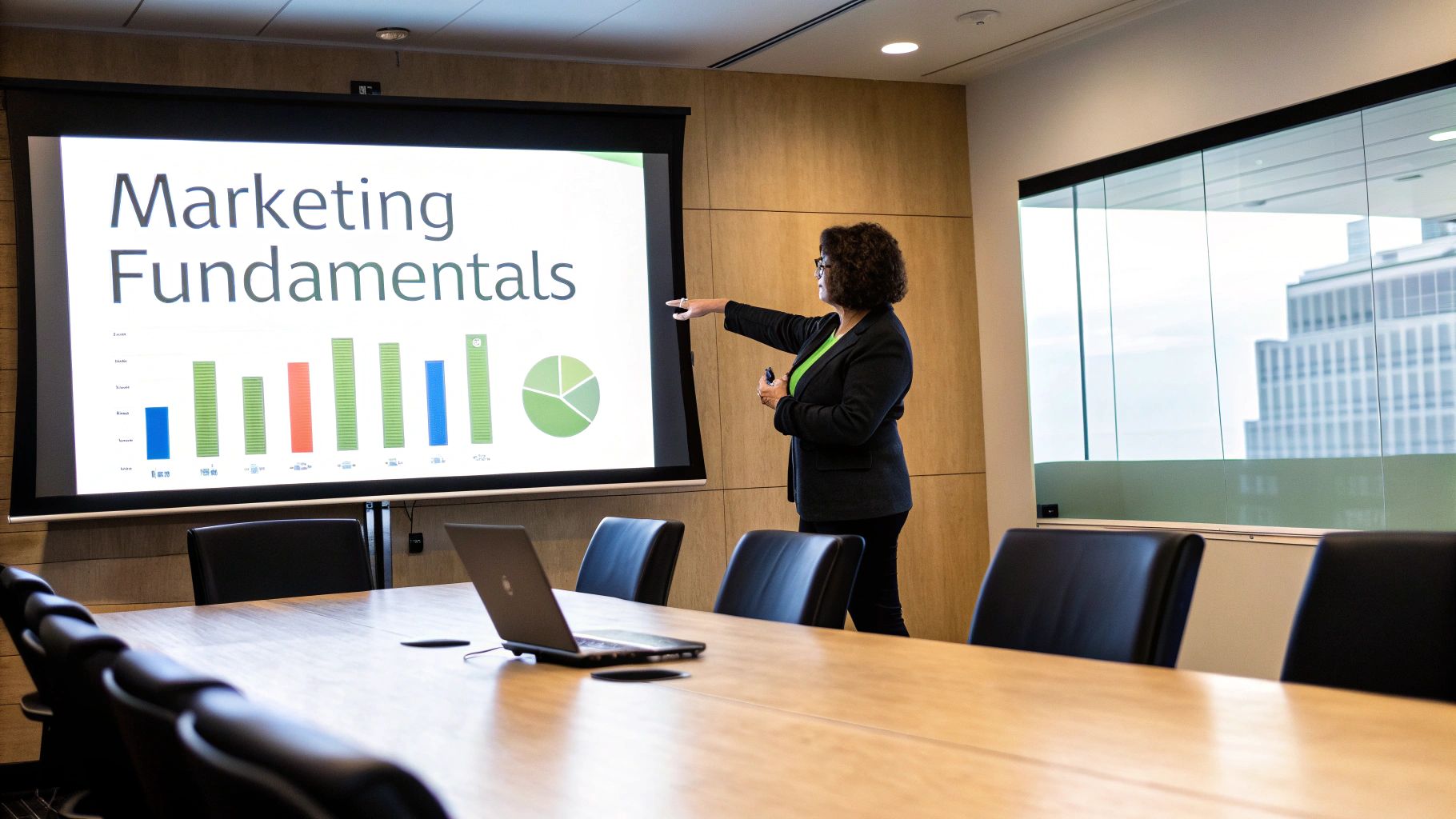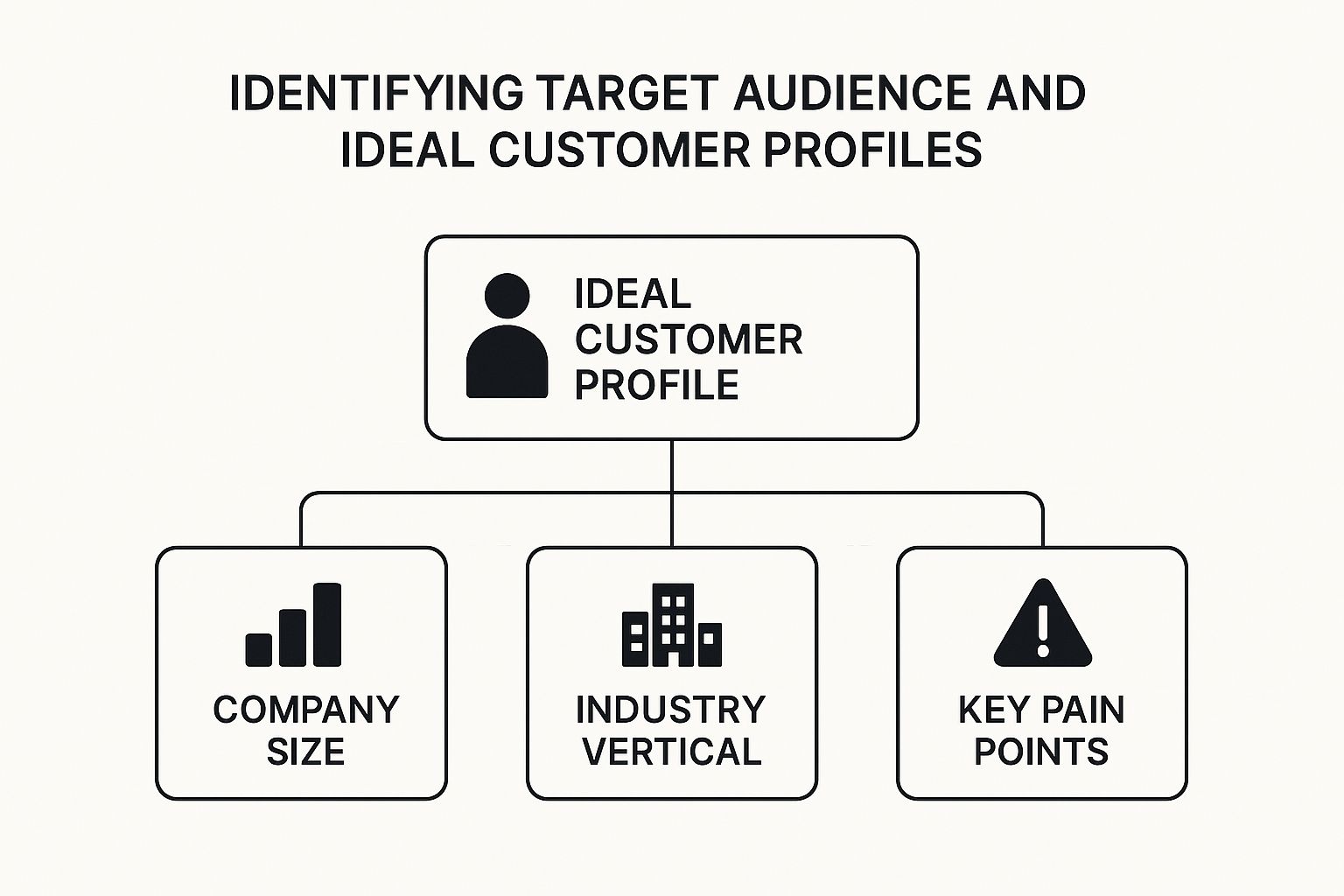At its core, B2B SaaS marketing is all about promoting subscription-based software to other companies. It’s not your typical sales pitch. Instead, it’s a long game focused on building relationships, demonstrating value over and over again, and earning trust to navigate what can be a very complex sales process. This approach is the bedrock of sustainable growth in a market where relationships mean everything.
Why B2B SaaS Marketing Is a Different Game

Selling a physical product—like a laptop or a desk—is usually a one-and-done deal. The customer buys it, and that’s pretty much the end of the story. B2B SaaS is a completely different world. It’s less like a transaction and more like starting a long-term partnership. The finish line isn't making the sale; it's keeping that customer happy and subscribed for years to come.
This single difference flips the entire marketing playbook on its head. The value you offer can't just be about flashy features on day one because the customer is signing up for an ongoing commitment. Your profitability isn't tied to the initial sign-up fee but to the lifetime value of that customer.
Navigating Complex Buying Journeys
In the B2B world, you’re almost never selling to just one person. More often than not, you're trying to win over a whole committee of people, and each one has their own agenda.
- The IT Manager: They’re worried about security, how your tool will integrate with their existing tech stack, and if it’s reliable.
- The CFO: Their focus is on the bottom line—ROI, total cost of ownership, and whether it fits the budget.
- The End-User: They just want a tool that’s easy to use and actually makes their job less of a headache.
- The Department Head: They're looking for big-picture wins, like improved team productivity and efficiency.
Your marketing has to speak to all of them at once. A winning strategy educates every single stakeholder, showing them exactly how your software solves their specific problems. It’s this educational approach that builds the consensus you need to get the deal signed.
The core of B2B SaaS marketing is a shift from selling features to demonstrating ongoing value. Your marketing doesn't stop at the point of sale; it's a continuous effort to prove your product's worth and keep customers engaged and successful.
The Critical Role of Trust and Retention
B2B sales cycles are long, often stretching out over several months. That means building trust isn't just a nice-to-have; it's absolutely essential. Buyers are making a significant investment and a long-term commitment. They need to believe in your product today and trust your company’s vision for the future.
This is where things like content marketing, detailed case studies, and transparent communication become your most powerful tools. They provide the proof and expert guidance people need to feel confident they're making the right call. To dig deeper into this, this comprehensive guide to B2B SaaS marketing offers some great insights into the unique challenges you'll face.
But remember, getting a customer is only half the battle. If customers are leaving as fast as you can sign them up, your business won't survive. A high churn rate is a SaaS killer, which makes customer retention just as crucial as lead generation. Your marketing needs to continue nurturing that relationship long after the sale, making sure users are getting the most out of your tool and seeing a clear return on their investment. That complete focus on the entire customer journey is what really sets great B2B SaaS marketing apart.
The Four Pillars of Your Marketing Strategy
A strong B2B SaaS marketing strategy is a lot like building a house—it needs a solid foundation to stand the test of time. You can't just throw up one wall and hope for the best. Instead, the most successful companies build their entire approach on four interconnected pillars.
Each pillar has its own job to do, but they're designed to work together to attract, engage, and ultimately win over customers. Getting a handle on these pillars is your first step toward building a marketing engine that doesn't just sputter along but truly drives growth. It's a framework that lets you put your resources where they matter most, ensuring no part of the customer journey gets ignored.
The B2B SaaS market is buzzing, thanks to big leaps in cloud computing and AI. Right now, private companies are hitting median annual growth rates of around 30% in 2024. That's a sign of a healthy market, but also a fiercely competitive one. To stand out, you need a strategy that pulls from all four of these core pillars.
An Overview of the Core Strategies
Think of these four strategies as different tools in your toolkit. Some are perfect for casting a wide net to see who's out there, while others are all about precision and hitting a very specific target.
Content Marketing: This is the art of pulling people in by creating and sharing genuinely helpful information. Instead of a hard sell, you’re solving your audience's problems with your content. This builds trust and positions you as the go-to expert in your field. To really sharpen your approach, you need to be applying data-driven marketing insights to figure out what’s actually working.
Paid Advertising: While your content builds a slow, organic burn, paid ads are like flipping a switch for immediate visibility. Platforms like Google Ads or LinkedIn let you get your message right in front of specific decision-makers—based on job title, industry, or company size—to kickstart your lead generation.
Partnership Marketing: This is all about teamwork. You collaborate with other businesses that aren't competitors but share a similar audience. By tapping into another company’s community, you get warm introductions and build credibility way faster than you could on your own.
Account-Based Marketing (ABM): ABM flips the whole marketing funnel upside down. Forget marketing to the masses. Here, you handpick a list of high-value "dream" accounts and treat each one like its own mini-market, crafting campaigns that speak directly to them.
But before you dive into any of these, you have to nail the first, most critical step: defining your Ideal Customer Profile (ICP). This diagram shows you what that looks like.

As you can see, it breaks down everything from company size and industry to the very specific pain points your software solves.
To make this a bit clearer, here’s a table breaking down how these four strategies stack up against each other.
Overview of Core B2B SaaS Marketing Strategies
| Strategy Pillar | Primary Goal | Key Metrics | Best For |
|---|---|---|---|
| Content Marketing | Build trust, authority, and organic traffic. | Organic Traffic, Engagement, MQLs | Long-term brand building and lead nurturing. |
| Paid Advertising | Drive immediate, targeted traffic and leads. | CPC, CPA, Conversion Rate | Scaling lead generation and testing offers quickly. |
| Partnership Marketing | Access new audiences and build credibility. | Referral Leads, Partner-Sourced Revenue | Entering new markets or building trust fast. |
| Account-Based Marketing | Land high-value, strategic accounts. | Account Engagement, Pipeline Velocity | Targeting large, complex enterprise deals. |
This table gives you a snapshot of what each pillar is designed to do, helping you decide where to focus your efforts based on your company's immediate goals.
Choosing the Right Mix for Your Business
None of these pillars are meant to work in a silo. The real magic happens when you blend them into a single, cohesive strategy. For example, you could use content marketing to attract a wide audience, then use paid ads to retarget the folks who seemed most interested with a specific demo offer. If you want to learn more, check out how to boost sales with blogs.
The most effective B2B SaaS marketing doesn't just execute on these four pillars individually. It integrates them, creating a system where each channel amplifies the others, guiding prospects seamlessly from awareness to conversion.
So, what's the perfect mix? It depends on your target audience, your budget, and where you are in your growth journey. A startup might go all-in on content and partnerships to get its first users. A bigger, more established company might pour its resources into a sophisticated ABM program backed by a hefty ad spend. The key is to start with a balanced approach, see what works, and adjust from there.
Building Authority with Content Marketing

In the world of B2B SaaS, trust isn't just a nice-to-have; it's the bedrock of your entire business. Your clients aren't making a quick, impulsive purchase. They're signing up for a long-term partnership, and they need to believe in your software, your team, and your company's direction.
This is where content marketing comes in, and it’s not about blasting sales pitches into the void. It’s about becoming the trusted expert in your field by consistently providing genuinely helpful information. You build authority one piece of content at a time.
Step into your customer's shoes for a moment. They're grappling with specific problems and hunting for answers. Your content needs to meet them right there, offering insights that show you truly get their challenges.
Going Beyond the Standard Blog Post
A regular blog is a fantastic starting point, but top-tier B2B SaaS content strategies go much deeper. The goal is to build a rich library of resources that speaks to different buyers at every stage of their decision-making process.
Some of the heaviest hitters in the B2B content world include:
- In-depth Whitepapers: These are your tools for tackling big, complex industry issues. A well-researched whitepaper full of data establishes you as a serious thought leader.
- Data-Driven Case Studies: There's no substitute for real-world proof. Case studies are your chance to show a potential customer, "We helped a business just like yours get these exact results."
- Engaging Webinars: Webinars give you a direct, personal connection with your audience. You can demo your product, answer questions live, and build real relationships.
By diversifying your content formats, you cater to how different people learn and what different roles—like a CFO versus an IT manager—need to see before they sign on. If you're looking to develop this kind of robust strategy, partnering with content marketing experts can give you the blueprint and execution you need to stand out.
Mapping Content to the Buyer Journey
Great content marketing isn't about throwing spaghetti at the wall to see what sticks. It's about creating a clear path that guides prospects from curiosity to conversion. The information someone needs when they're just starting to research a problem is completely different from what they're looking for when they're comparing you to a competitor.
The most powerful B2B SaaS content marketing anticipates the questions customers will have at each stage of their journey and provides the answers before they even have to ask. It's about being the helpful guide they didn't know they needed.
A smart way to organize your efforts is by mapping content to these key stages:
- Awareness Stage: At this point, your audience knows they have a problem but isn't sure what the solution is. Your content should focus on their pain points. Think blog posts like "5 Signs Your Manual Invoicing is Costing You Money."
- Consideration Stage: Now they're actively researching options. This is the perfect time for detailed comparison guides, expert-led webinars, and case studies that highlight what makes your product the best choice.
- Decision Stage: The prospect is close to making a choice but needs that final push of confidence. This is where ROI calculators, free trial walkthroughs, and clear implementation guides can seal the deal.
Just look at HubSpot's blog—it's a masterclass in this approach. They've built an enormous library that covers every possible question for every stage of the journey.

The image shows how they organize their content by business function—Marketing, Sales, Service—so every professional can easily find exactly what they need, when they need it.
When you take this structured approach, your content becomes more than just a marketing tactic. It becomes an engine that consistently attracts visitors, nurtures them into leads, and ultimately turns them into loyal customers who trust you.
Accelerating Growth with Paid Ads and ABM
Content marketing is your long game—it builds trust and establishes you as an authority. But sometimes you need results now. That’s where paid advertising and Account-Based Marketing (ABM) come in. Think of them as powerful accelerators for your B2B SaaS growth engine.
Paid ads are like flipping a switch on a high-powered spotlight. Instead of waiting for people to wander over to you, you pay to shine your message directly where your ideal customers are looking. It's all about speed and precision, giving you a fast way to get leads and test what messages work.
ABM, on the other hand, is a totally different way of thinking. If traditional marketing is like fishing with a giant net hoping to catch a few good fish, ABM is like spear-fishing. You’re not trying to get everyone; you’re going after specific, high-value targets with a carefully planned approach.
Precision Targeting with Paid Advertising
The real magic of paid ads for B2B SaaS is the insane level of targeting you can achieve. Platforms like LinkedIn and Google Ads let you get incredibly specific, moving way beyond simple demographics to find the exact decision-makers you need.
You can build entire audiences based on criteria that actually matter in a B2B sale, like:
- Job Title: Want to talk directly to VPs of Sales, IT Directors, or CFOs? You can.
- Company Size: Only want to focus on businesses with 50-200 employees? Easy.
- Industry: You can show your ads exclusively to companies in finance or healthcare.
This kind of control means you stop wasting money on people who will never buy. You're paying to get in front of the folks who hold the purse strings, making it a super-efficient way to load up your sales pipeline. Of course, getting paid ads right is more than just setup; you'll find that mastering PPC campaign management is key to getting the best long-term results.
Adopting a Spear-Fishing Mentality with ABM
Account-Based Marketing completely flips the old marketing funnel upside down. Instead of casting a wide net for leads and hoping a few of them convert, ABM starts by hand-picking a list of "dream" accounts that are a perfect fit for your software.
The core idea behind ABM is simple: treat each target account like its own market. Your marketing and sales teams have to work in lockstep to create a personalized buying experience that speaks directly to that one company's unique needs and key players.
For this to work, your marketing and sales departments can't be in separate silos. They need to team up, identify the key people within a target company, and then create custom content and outreach that hits on their specific problems.
This strategy is so effective because it’s personal. A decision-maker won't just see a generic ad. Instead, they might see a case study about a company in their exact industry, get a personalized email from a sales rep who mentions their company's latest news, and then see a targeted ad on LinkedIn that speaks to a pain point they're actually feeling. Understanding this kind of targeted journey is fundamental to learning how to get customers via a sales funnel.
This push toward more focused strategies makes sense when you look at the market. By 2025, it's predicted that 85% of all business software will be SaaS-based. The B2B world is becoming dominated by subscriptions, which means marketers have to constantly prove their value. Paid ads and ABM are two of the best ways to do just that.
When you combine the targeted reach of paid advertising with the laser focus of ABM, you create a seriously powerful growth strategy.
How to Measure Your Marketing ROI

Any marketing campaign without a way to measure it is just expensive guesswork. In the world of B2B SaaS, you simply can't afford to throw money at the wall and see what sticks. You need to prove that your strategies are delivering real, tangible value to the business.
This means looking past "vanity metrics" like social media likes and digging into the numbers that your CEO and investors actually care about.
Measuring your Return on Investment (ROI) isn't just about justifying your budget, either. It’s how you figure out what's working so you can double down on it. It’s also how you spot the channels that are just draining your resources. A data-driven approach is what turns marketing from a cost center into a predictable engine for growth.
Decoding Core SaaS Metrics
To prove your marketing is making an impact, you have to speak the language of the SaaS business model. A few key metrics are the bedrock of any conversation about ROI. They create a direct line between your marketing spend and the company's revenue.
Customer Acquisition Cost (CAC): This is the total price you pay in sales and marketing to get one new customer on board. To figure it out, just divide your total marketing and sales spending over a set period by the number of new customers you brought in during that same time.
Lifetime Value (LTV): This number predicts the total amount of money a single customer will bring in over their entire time with your company. LTV helps you see the long-term payoff of each customer you win, shifting the focus from a one-time sale to a lasting relationship.
Monthly Recurring Revenue (MRR): MRR is the lifeblood of any SaaS company. It's the predictable revenue you can count on coming in every single month. Watching your MRR grow is one of the clearest signs that your marketing is hitting the bottom line.
Getting a handle on these metrics is the first step. They give you a clear, standard way to talk about and measure success.
The Golden Ratio LTV to CAC
Taken by themselves, LTV and CAC are useful. But the real magic happens when you put them together. The LTV-to-CAC ratio is arguably the most important metric for checking the health of a SaaS business.
This simple ratio shows you how much value you’re getting back for every single dollar you spend to bring in a new customer. A healthy B2B SaaS business should be aiming for an LTV-to-CAC ratio of 3:1 or higher. In plain English, for every dollar you spend on acquisition, you should be making at least three dollars back over that customer's lifetime.
A ratio under 1:1 is a serious red flag—it means you're literally losing money on every new customer. On the flip side, a ratio of 5:1 or higher might mean you're not investing enough in marketing and could be growing even faster.
Keeping a close eye on this ratio ensures your marketing efforts aren't just busy work; they're profitable and sustainable. It's the ultimate proof that what you're doing is working.
Connecting Actions to Results with Attribution
Okay, so you know your LTV and CAC. That’s great. But how do you know which specific marketing channels are bringing in the best customers? That's where attribution models come into play.
Attribution is just a fancy way of saying you're giving credit to the different touchpoints a person interacts with on their way to becoming a customer.
There are a few different ways to look at it:
- First-Touch Attribution: This gives 100% of the credit to the very first thing a lead did, like reading that first blog post they found on Google.
- Last-Touch Attribution: This model gives all the credit to the final touchpoint right before they converted, like clicking a specific paid ad.
- Multi-Touch Attribution: This approach spreads the credit out across multiple touchpoints, giving you a more complete picture of how all your channels work together to close a deal.
Picking the right model helps you see which content, ads, or campaigns are actually driving revenue. This allows you to put your money where it will have the biggest impact. This is vital for keeping customers, too, since annual churn rates can be anywhere from 5% to 7%. Even a tiny 5% drop in churn can boost profits by up to 95%. You can learn more about these kinds of important SaaS statistics from zylo.com.
Common Marketing Mistakes to Avoid
Getting B2B SaaS marketing right often means learning what not to do. Even campaigns with huge budgets can completely miss the mark if they stumble into a few common, costly traps. If you can sidestep these errors from the get-go, you'll build a much stronger and more effective marketing engine.
The road to growth is paved with good intentions, but it's surprisingly easy to get pulled off course by the wrong priorities. By knowing what these pitfalls look like, you can steer clear, saving a ton of time and money in the process.
Focusing Only on New Customers
This is one of the biggest mistakes we see: an obsession with customer acquisition while completely ignoring customer retention. It's exciting to see new logos pop up on your client list, but what's the point if you have a leaky bucket? If customers are churning out the back door as fast as you bring them in, you're not actually growing.
Remember, getting a new customer can cost five times more than keeping one you already have. Your current customers are also your best bet for upselling and cross-selling, which is how you really boost your Lifetime Value (LTV).
What to do instead: Don't put all your eggs in one basket. Carve out a piece of your marketing budget for customer success, create helpful content for your existing users, and think about loyalty programs. Great onboarding and consistent engagement are marketing's job, too—not just support's.
Selling Features Instead of Solutions
Your team poured their hearts into building your software's amazing features, and you're proud of them. The mistake is thinking your customers care about the technical details as much as you do. They don't buy features; they buy solutions to their biggest headaches.
When your marketing just lists off features, it doesn't connect with what your customer actually needs. A CFO doesn't care about your "asynchronous data processing algorithm." They care that it will slash their team's invoicing errors by 30% and save 40 hours of mind-numbing manual work every single month.
- Mistake: "Our platform offers real-time analytics dashboards."
- Better: "Make faster, data-backed decisions with instant insights into your team's performance, and stop relying on guesswork."
It's a simple shift from "what our product is" to "what our product does for you," but it makes all the difference.
Misapplying Consumer Marketing Tactics
The playbook that sells a pair of sneakers simply won't work for a complex software platform with a five-figure annual contract. B2C marketing often plays on impulse buys and emotional triggers with massive, broad-stroke campaigns. Trying to copy-paste that strategy into B2B SaaS is just a fast way to burn through your ad budget on bad leads.
The B2B buying journey is long. It involves multiple people, all of whom need to see a logical, data-driven case for ROI. Flash sales and FOMO-driven social media ads just don't land with a buying committee that's about to make a decision impacting their entire department.
Letting Sales and Marketing Work in Silos
This is a classic. When marketing and sales teams operate on different planets, the customer experience feels broken. Marketing generates a flood of leads that sales says are junk, while sales struggles to close deals because they don't have the right content or support.
This disconnect is a massive waste of resources and creates a ton of internal friction. For any B2B SaaS strategy to actually work, these two teams need to be perfectly aligned on goals, messaging, and what a "qualified lead" even is. That partnership creates a smooth handoff from prospect to happy customer, which boosts conversion rates across the board.
Frequently Asked Questions
Every B2B SaaS marketer hits a few roadblocks. Let's tackle some of the most common questions that come up when you're in the thick of it, with clear answers to keep you moving forward.
How Can I Market a SaaS Product with a Small Budget?
Marketing a SaaS product when you're strapped for cash is all about smart, scrappy tactics. You need to focus on channels that cost more time than money. Forget about blowing your budget on big ad campaigns for now.
Your absolute best friend here is content marketing. Start creating genuinely helpful blog posts, guides, and checklists that solve a real problem for your target customer. This helps you show up in search results and builds trust without a huge ad spend. Also, start building an email list from day one—it's a direct line to your audience that you own.
What Is the Difference Between Product-Led and Sales-Led Growth?
The main difference is how a potential customer first gets to know your product. It’s like the difference between tasting a free sample at Costco and having a chef give you a personal cooking demonstration.
- Product-Led Growth (PLG): The product does the selling. Companies use freemium plans or free trials to let people see how valuable the tool is on their own time, long before they ever chat with a salesperson.
- Sales-Led Growth (SLG): This is the classic approach where a sales team does the heavy lifting. They find leads, educate them, and convince them to buy. This is common for complex, big-ticket SaaS products that need a lot of hand-holding.
With PLG, the user discovers the "aha!" moment by themselves. With SLG, a salesperson points it out for them. Today, many of the smartest companies are mixing both approaches to get the best results.
How Long Does Content Marketing Take to Show Results?
This is the big one, and the answer is simple: be patient. Content marketing isn't like flipping a switch on a paid ad. It’s a long-term play that builds on itself. You can generally expect to see real results, like a solid bump in organic traffic and leads, within 6 to 9 months of consistent work.
And the key word there is consistent. You can't just publish one article and expect the floodgates to open. Success comes from a steady rhythm of creating great, SEO-focused content, getting it in front of people, and building authority over time. The start is always slow, but the growth can become exponential once you get rolling.
Ready to stop guessing and start ranking? Copy Masters delivers 30 search-optimized articles every month, turning your blog into a predictable engine for traffic, leads, and sales. See how our low-risk, high-impact SEO content system can help you win online at https://copymasters.co.
- A Guide to B2B SaaS Marketing - August 16, 2025
- Improving Search Engine Rankings: Your Practical Masterclass - August 15, 2025
- Copywriting vs. Content Writing: Which is Better for Your Marketing? - August 13, 2025
